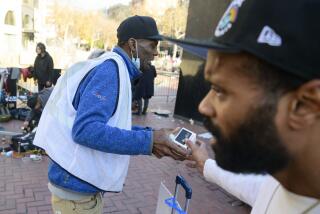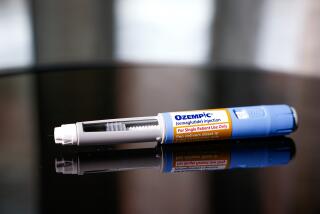Minorities Missing Out on Revolution in AIDS Drugs
- Share via
For two months recently, Maximus Clary took a powerful set of drugs that held the promise of sending the AIDS virus in his body into retreat. Then he threw his pills out.
He hated the drugs’ side effects, which left him feeling nauseated and generally lousy. So he went back to ginseng and licorice root.
“In my family we believe in the natural stuff, the herbs and stuff like that,” said Clary, 30, who is African American. “I tell people, ‘don’t put your faith in those medications.’ ”
He is one of many missing from the treatment revolution that has dramatically cut AIDS deaths and revived thousands in the last two years.
Although the high cost of new drug therapy keeps people off the treatment rolls in some parts of the country, that is generally not the case in California. The state has poured more money than any other into a program that pays for AIDS medications for those who can’t afford them.
“Everybody can get drugs,” said Larry Mims, a Los Angeles AIDS prevention advocate with the Black Lesbian and Gay Leadership Forum. “It’s not if you have insurance or don’t have insurance. That’s not the issue.” Rather, experts say, a complex host of social and cultural factors is often at work, with the AIDS-savvy, better educated and medically sophisticated more likely to be using the new medications. And in a trend that accentuates rising infection rates among minorities and women, research indicates that they are not taking the drugs to the same degree as whites and men.
To understand why, consider the contrasting practices of Dr. Gary Cohan and Dr. Wilbert Jordan.
Disparities in Knowledge, Support
Cohan is a partner in Pacific Oaks Medical Group in Beverly Hills, one of the largest private HIV-AIDS specialist groups in the country. His patients are mostly middle-class or upper-middle-class gay men. They get tested for HIV, the virus that causes AIDS, and usually come to him well before the disease has progressed to full-blown AIDS.
They know the medical lingo of viral load--the level of AIDS virus in the blood--and protease inhibitors, one of the key new drug types. They are likely to know others with the disease and can fall back on a well-established support network, where AIDS is neither shameful nor hidden.
Jordan’s patients at the Oasis Aids Clinic at Martin Luther King Jr./Drew Medical Center are mostly poor and minority. The closet looms larger in this world. There is less acknowledgment of AIDS risk, less community support, more fear of the stigma of the disease and more suspicion of the medical establishment.
Jordan speaks of patients who wear wigs to his clinic so no one will recognize them. He remembers the man who was so terrified of being seen in the waiting room by two of his neighbors that he fled, breaking a window.
Jordan mentions the ministers he quietly treats on the weekend, out of sight. He talks about the women who don’t think they are at risk and haven’t a clue they have AIDS until they are in the hospital. He speaks of how, in the African American community, he has had to approach churches about helping people with AIDS, rather than the other way around.
All of that means it is less likely that the Oasis clients were routinely tested for HIV or entered treatment in the early stages of the disease. It means that once their conditions are diagnosed, they may not want to pop a fistful of pills every day, inviting questions about their health.
If they are undocumented immigrants, they may consider visits to an AIDS clinic a one-way ticket out of the country. And if they are African American, the memory of the government’s indifference to the health of black men in the infamous Tuskegee syphilis study may steer them clear of conventional treatment altogether.
“All you have to say is ‘Tuskegee,’ ” said Dr. Gildon Beall, director of the Beall Clinic at Harbor-UCLA Medical Center. “There is a deep and abiding distrust of the largely white medical establishment by African Americans.”
Clary, for one, thinks the new AIDS drugs are made for whites, who he believes can better tolerate them.
“I do not trust those medicines because I see a lot of nonminority racists cope with the medicines,” Clary said. “The medicines genetically are made for a specific race--the Caucasian race.”
Treatment disparities are reflected in AIDS statistics.
In Los Angeles County--where there are about 40,000 people with HIV and 13,130 living with AIDS--new AIDS cases dropped significantly between 1996 and 1997. But the decline was greater for men than for women, and markedly greater for whites than for blacks and Latinos.
Part of that pattern can be explained by the climb in infections in women and minorities. Nationally, AIDS is the leading cause of death among African Americans between the ages of 25 and 44. But the uneven drop in AIDS cases also suggests that whites and men are more often diagnosed early and start taking the new medications, which can help stop HIV from progressing to AIDS.
“Whites and men seem to be benefiting more than [other] groups in getting treatment before AIDS develops,” said Los Angeles County epidemiologist Dr. Paul Simon. “The early diagnosis is really important and I don’t think we’re doing a good enough job in certain communities.”
Demographic differences were also apparent in a Los Angeles County study that showed that African Americans and foreign-born Latinos with AIDS were less likely than whites and U.S.-born Latinos to be prescribed protease inhibitors, a standard part of the drug cocktail. Women were less likely than men to be on an inhibitor.
When the federal Centers for Disease Control and Prevention took a look at new AIDS cases reported last year in California and New Jersey, it found that African Americans, people who inject drugs, people 60 or older, and those on Medicaid or without health insurance were all less likely to have taken a test determining the viral load in their blood--a key to choosing the proper combination drug therapy.
Even when insurance coverage was not an issue, distinctions remained. For instance, a black person with private health insurance was less likely than an insured white person to have taken the viral test.
A follow-up survey in Los Angeles found that once people had been in care for a while, the number taking a three-drug combination rose. Again, the issue seemed not so much to be access to the drugs as the fact that people did not start treatment until they developed AIDS. They were, to some extent, developing AIDS because they had not been treated for HIV.
“The problem is roughly late testing and delayed entry into care,” said Centers for Disease Control epidemiologist Dr. Paul Denning, who supervised the study.
Social Patterns Emerge in Treatment
But even early testing is no assurance that people will begin treatment. In a Los Angeles County survey of 60 people recently found to have HIV, only 41% chose to immediately start the new drug therapies, even after they were told of the potential benefits.
A quarter wanted to think about it and 35% just said no. They were afraid of the drugs’ possible side effects, concerned that they might exhaust their treatment options too early in the disease or worried that if they started taking medications, word would get out that they are infected.
Once more, social patterns emerged. “People of color and lower education tend to use the new therapies later, and that’s not entirely explained by the fact that they have poorer access” to the medical system, county health epidemiologist Walt Senterfitt said, suggesting, like Jordan, that issues such as trust and the absence of social support may play a role.
Roderick, 32, is Latino and black. He is all too familiar with that lack of support.
His white friends are very open about having HIV or AIDS, he said, but “in the black and Latino community, you don’t talk about it. . . . You’re just targeted like a leper.”
That is not to suggest that whites don’t face ostracism. The fear of discovery kept one of Donald DuBois’ friends--an openly gay white man--off the drugs until shortly before his death.
“The last three weeks, when he finally decided to get on them, it was actually too late,” DuBois recalled. “He didn’t want his job or insurance to find out.”
Low income is another factor in the minority community. Harsh economics have fostered a mind-set of not going to the doctor until one’s health collapses, said Bishop Carl Bean of the Minority AIDS Project in Los Angeles.
And some avoid the new drugs because they suspect that they will eventually fail, as previous AIDS treatments have. “There’s a great deal of suspicion out there about when the other shoe is going to drop with these drugs,” said Thomas Coates, director of UC San Francisco’s AIDS Research Institute.
Moreover, it is no simple thing to embark on the new treatments.
Multiple pills have to be taken two or three times a day. Some have to be planned around meals or require the patient to drink large amounts of water. There can be unpleasant side effects, including nausea and diarrhea.
If patients regularly miss doses, they could develop a drug-resistant strain of the virus. Unlike cancer treatment, which ends after a fixed period of time, the drug therapy continues indefinitely.
Sporadic Medication Causes Problems
That can all be too much to handle. “It turns your life upside-down,” said Joseph, 42, an HIV counselor who has had the AIDS virus for years but eschews HIV drugs. “Quite frankly, I don’t know if I would have the patience.”
Just watching friends take the new therapies makes him uneasy. “It’s a frightening feeling to have people tied to a timer or a pill box,” he said.
Bill, 42, turned red with a bad rash when he took AZT, an older AIDS drug. The new therapy scares him. “I don’t know what it might do,” he said.
For those on society’s margins, the drugs can be even more daunting.
One of Ruben Acosta’s clients is a 32-year-old homeless man with the AIDS virus. For six months, he has been wandering around Hollywood and Pasadena with a prescription for AIDS medications. He keeps telling Acosta he can’t fill it until he finds a place to stay--which he never does.
“It’s more than a piece of paper now. It’s almost like a partner,” says Acosta, a treatment advocate with the AIDS Service Center in Pasadena. He has repeatedly told the man how effective the drugs can be. But so far his client remains more interested in another drug: methamphetamine.
At the same time, concerns about resistant viruses have made some physicians reluctant to prescribe the medications to patients who they believe will skip doses.
“There is a significant number of physicians who really do feel the addicted population has a tendency to be noncompliant,” said Suzi Rodriguez, co-chair of the Los Angeles County HIV, Drug and Alcohol Task Force. “So they don’t want to give them these expensive drugs.”
There are some efforts to address social issues that interfere with treatment. Using federal and city grants, Charles R. Drew University and the UCLA Center for Clinical AIDS Research and AIDS Education are experimenting with programs aimed at ethnic minorities, substance abusers and people with housing problems to see if regular counseling makes a difference in treatment adherence.
The AIDS Healthcare Foundation in Los Angeles was also given $1 million in federal money last fall to run a short-term residential program for the homeless and others at risk of falling off the treatment wagon for nonmedical reasons.
Elsewhere in the country, cost remains a major treatment barrier.
Few can afford the $10,000- to $15,000-a-year combination drug therapies without good medical coverage or government help. In some states there simply aren’t enough dollars in the federal-state AIDS drug program to pay for medications for everyone who wants them.
Nine states have capped their enrollment in the AIDS Drug Assistance Program, according to the National Alliance of State and Territorial AIDS Directors. In Florida, for example, 2,200 people are on a waiting list for AIDS medications. A handful of states have waiting lists for people to obtain protease inhibitors.
Not in California, where combined federal-state funding for the AIDS Drug Assistance Program has climbed to $90.3 million, up from $17.5 million two years ago. Medi-Cal also covers AIDS drugs.
That treatment gaps nonetheless persist underscores how difficult--if not impossible--it will be to eliminate them all.
“It’s become even more of a disease of have and have-nots,” Cohan said of the new treatment era. “When there was nothing we could do, everyone could have the same nothing.”
* SUCCESSFUL PROGRAM
Free condoms at an L.A. school promoted safety but not sexual activity, a study found. B1
(BEGIN TEXT OF INFOBOX / INFOGRAPHIC)
AIDS in California
Statewide statistics show AIDS cases on the rise among minorities and women:
Percentage of new AIDS cases in California, by category
Whites
1989: 68.4%
1997: 44.3%
*
African Americans
1989: 13.6%
1997: 23%
*
Latinos
1989: 15%
1997: 29.4%
*
Women
1989: 4.5%
1997: 11.8%
Overall, the number of new AIDS cases reported in Los Angeles County dropped 31% from 1996 and 1997, but the decline was not uniform.
Percentage drop in new AIDS cases reported
Men: 32%
Women: 20%
Whites: 44%
African Americans: 19%
Latinos: 18%
A 1996-1997 review of 339 Los Angeles County residents with AIDS revealed demographic differences in the use of protease inhibitors, a key type of new AIDS drug.
Percentage taking protease inhibitors
64%: Men
56%: Women
71%: Whites
69%: U.S.- born Latinos
63%: Asian/Pacific Islanders
57%: African American
53%: Foreign- born Latinos
Source: Los Angeles County Department of Health Services, California Department of Health Services







